2007 FORD EXPLORER steering wheel
[x] Cancel search: steering wheelPage 248 of 344
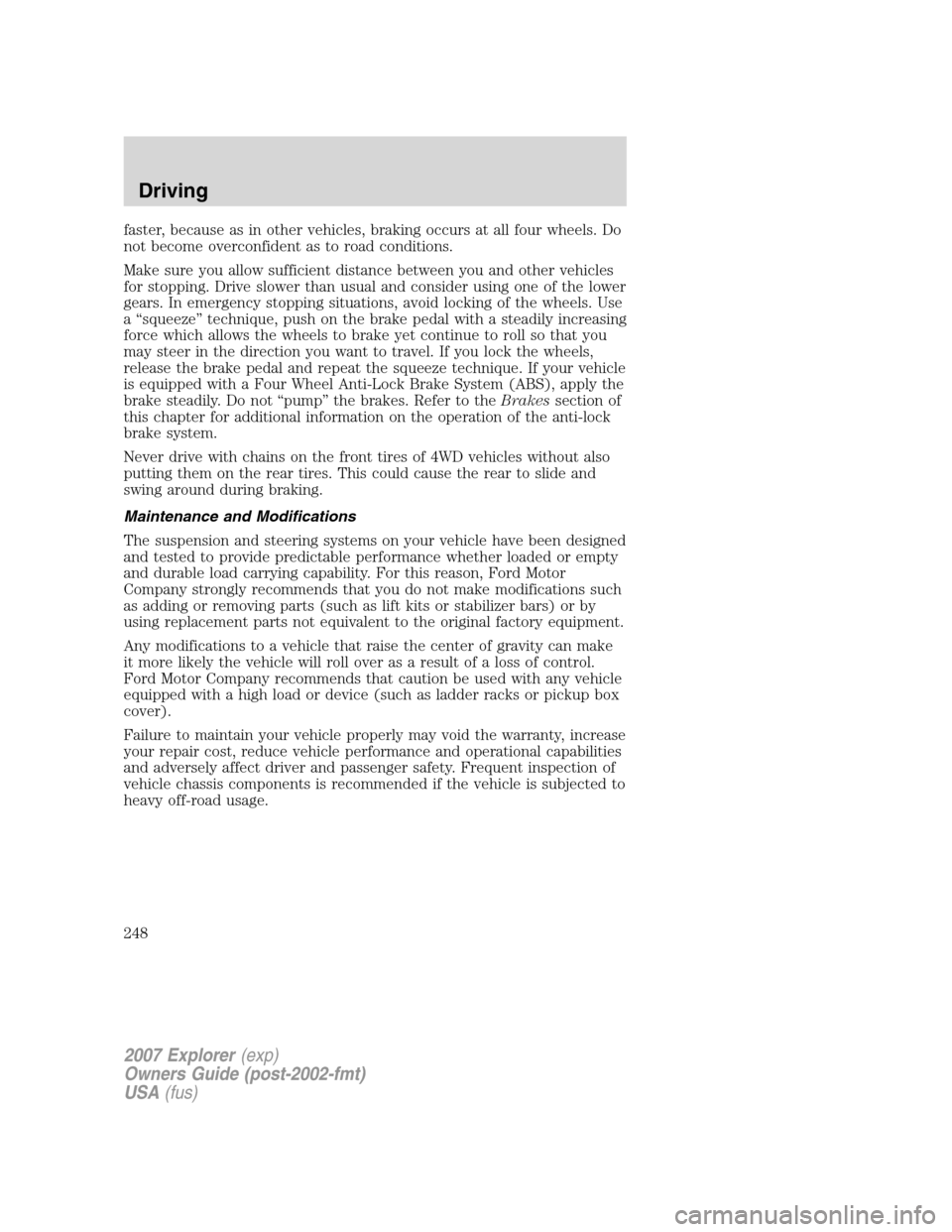
faster, because as in other vehicles, braking occurs at all four wheels. Do
not become overconfident as to road conditions.
Make sure you allow sufficient distance between you and other vehicles
for stopping. Drive slower than usual and consider using one of the lower
gears. In emergency stopping situations, avoid locking of the wheels. Use
a “squeeze” technique, push on the brake pedal with a steadily increasing
force which allows the wheels to brake yet continue to roll so that you
may steer in the direction you want to travel. If you lock the wheels,
release the brake pedal and repeat the squeeze technique. If your vehicle
is equipped with a Four Wheel Anti-Lock Brake System (ABS), apply the
brake steadily. Do not “pump” the brakes. Refer to theBrakessection of
this chapter for additional information on the operation of the anti-lock
brake system.
Never drive with chains on the front tires of 4WD vehicles without also
putting them on the rear tires. This could cause the rear to slide and
swing around during braking.
Maintenance and Modifications
The suspension and steering systems on your vehicle have been designed
and tested to provide predictable performance whether loaded or empty
and durable load carrying capability. For this reason, Ford Motor
Company strongly recommends that you do not make modifications such
as adding or removing parts (such as lift kits or stabilizer bars) or by
using replacement parts not equivalent to the original factory equipment.
Any modifications to a vehicle that raise the center of gravity can make
it more likely the vehicle will roll over as a result of a loss of control.
Ford Motor Company recommends that caution be used with any vehicle
equipped with a high load or device (such as ladder racks or pickup box
cover).
Failure to maintain your vehicle properly may void the warranty, increase
your repair cost, reduce vehicle performance and operational capabilities
and adversely affect driver and passenger safety. Frequent inspection of
vehicle chassis components is recommended if the vehicle is subjected to
heavy off-road usage.
2007 Explorer(exp)
Owners Guide (post-2002-fmt)
USA(fus)
Driving
248
Page 252 of 344
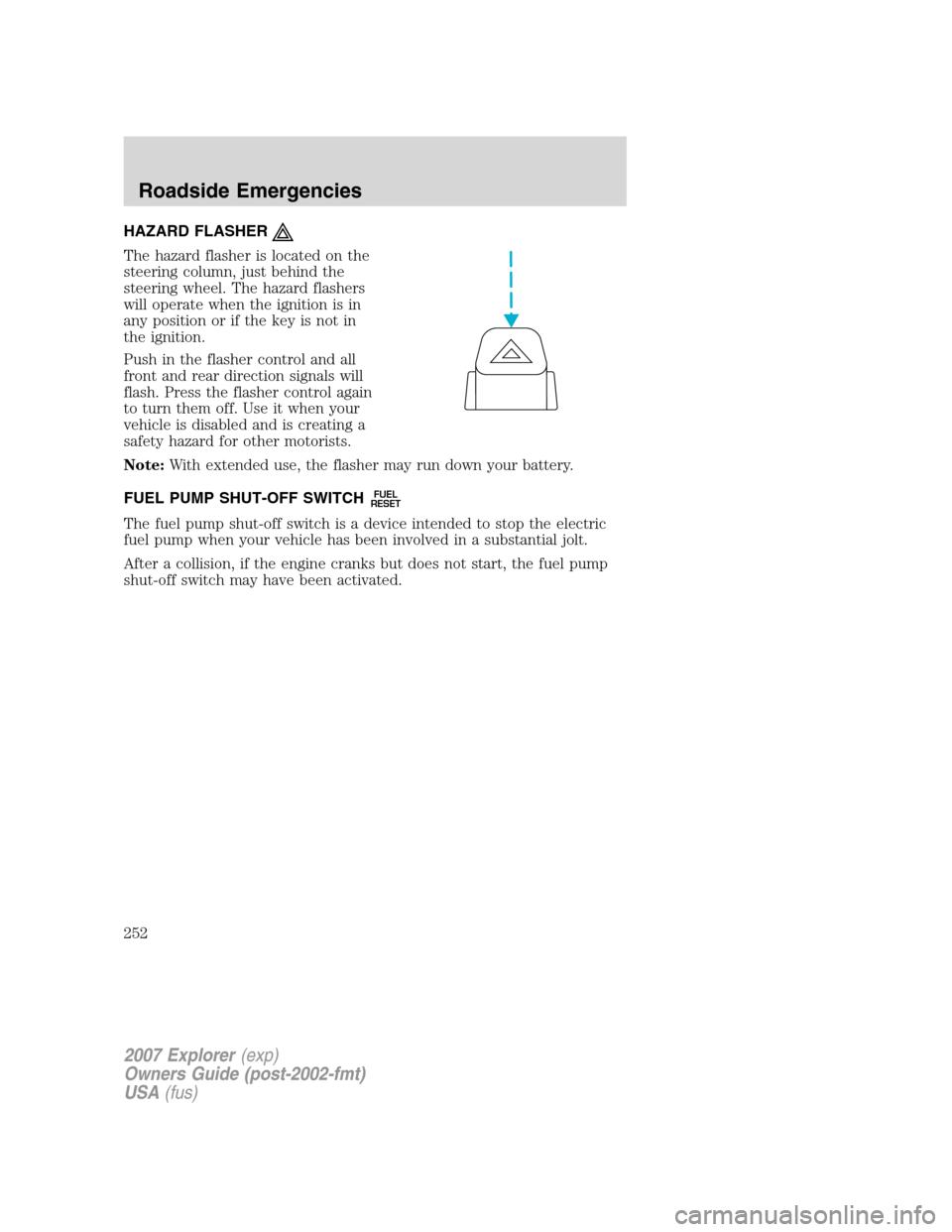
HAZARD FLASHER
The hazard flasher is located on the
steering column, just behind the
steering wheel. The hazard flashers
will operate when the ignition is in
any position or if the key is not in
the ignition.
Push in the flasher control and all
front and rear direction signals will
flash. Press the flasher control again
to turn them off. Use it when your
vehicle is disabled and is creating a
safety hazard for other motorists.
Note:With extended use, the flasher may run down your battery.
FUEL PUMP SHUT-OFF SWITCH
FUEL
RESET
The fuel pump shut-off switch is a device intended to stop the electric
fuel pump when your vehicle has been involved in a substantial jolt.
After a collision, if the engine cranks but does not start, the fuel pump
shut-off switch may have been activated.
2007 Explorer(exp)
Owners Guide (post-2002-fmt)
USA(fus)
Roadside Emergencies
252
Page 261 of 344

Fuse/Relay
LocationFuse Amp
RatingPower Distribution Box
Description
42 15A* Redundant brake switch, EVMV,
MAFS, HEGO, EVR, VCT1, VCT2,
CMCV, CMS
43 15A* Coil on plug (4.6L engine only),
Coil tower (4.0L engine only)
44 15A* Injectors
45A — Not used
45B — GCC fan relay
46A — Not used
46B — Not used
47 — Front wiper relay
48 — PCM relay
49 — Fuel pump relay
50A — Fog lamps relay
50B — AC clutch relay
51 — Not used
52 — A/C clutch (diode)
53 — Not used
54 — Trailer battery charger relay
55 — Starter relay
56 — Blower relay
* Mini Fuses ** Cartridge Fuses
CHANGING THE TIRES
If you get a flat tire while driving:
•do not brake heavily.
•gradually decrease the vehicle’s speed.
•hold the steering wheel firmly.
•slowly move to a safe place on the side of the road.
Note:The tire pressure monitoring system (TPMS) indicator light will
illuminate when the spare is in use. To restore the full functionality of
the monitoring system, all road wheels equipped with tire pressure
monitoring sensors must be mounted on the vehicle.
2007 Explorer(exp)
Owners Guide (post-2002-fmt)
USA(fus)
Roadside Emergencies
261
Page 264 of 344

When driving with the full-size dissimilar spare tire/wheel additional
caution should be given to:
•Towing a trailer
•Driving vehicles equipped with a camper body
•Driving vehicles with a load on the cargo rack
Drive cautiously when using a full-size dissimilar spare tire/wheel and
seek service as soon as possible.
Stopping and securing the vehicle
1. If you get a flat tire while driving,
do not apply the brake heavily;
instead, gradually decrease your
speed. Hold the steering wheel
firmly and slowly move to a safe
place on the side of the road.
2. Park on a level surface, activate
the hazard flashers and set the
parking brake.
3. Place gearshift lever in P (Park)
and turn engine OFF.
When one of the rear wheels is off the ground, the transmission
alone will not prevent the vehicle from moving or slipping off the
jack, even if the transmission is in P (Park).
4. Turn off the power running boards (if equipped). Refer toRunning
boardsin theDriver Controlschapter.
Note:Passengers should not remain
in the vehicle when the vehicle is
being jacked.
5. Block the wheel that is diagonally
opposite of the flat tire using the
wheel chock provided with your
vehicle.
Location of the spare tire and tools
Have a flat tire serviced by an authorized dealer in order to prevent
damage to the TPMS sensor, refer toChanging tires with TPMSin the
Tires, Wheels and Loadingchapter. Replace the spare tire with a road
tire as soon as possible.
2007 Explorer(exp)
Owners Guide (post-2002-fmt)
USA(fus)
Roadside Emergencies
264
Page 292 of 344
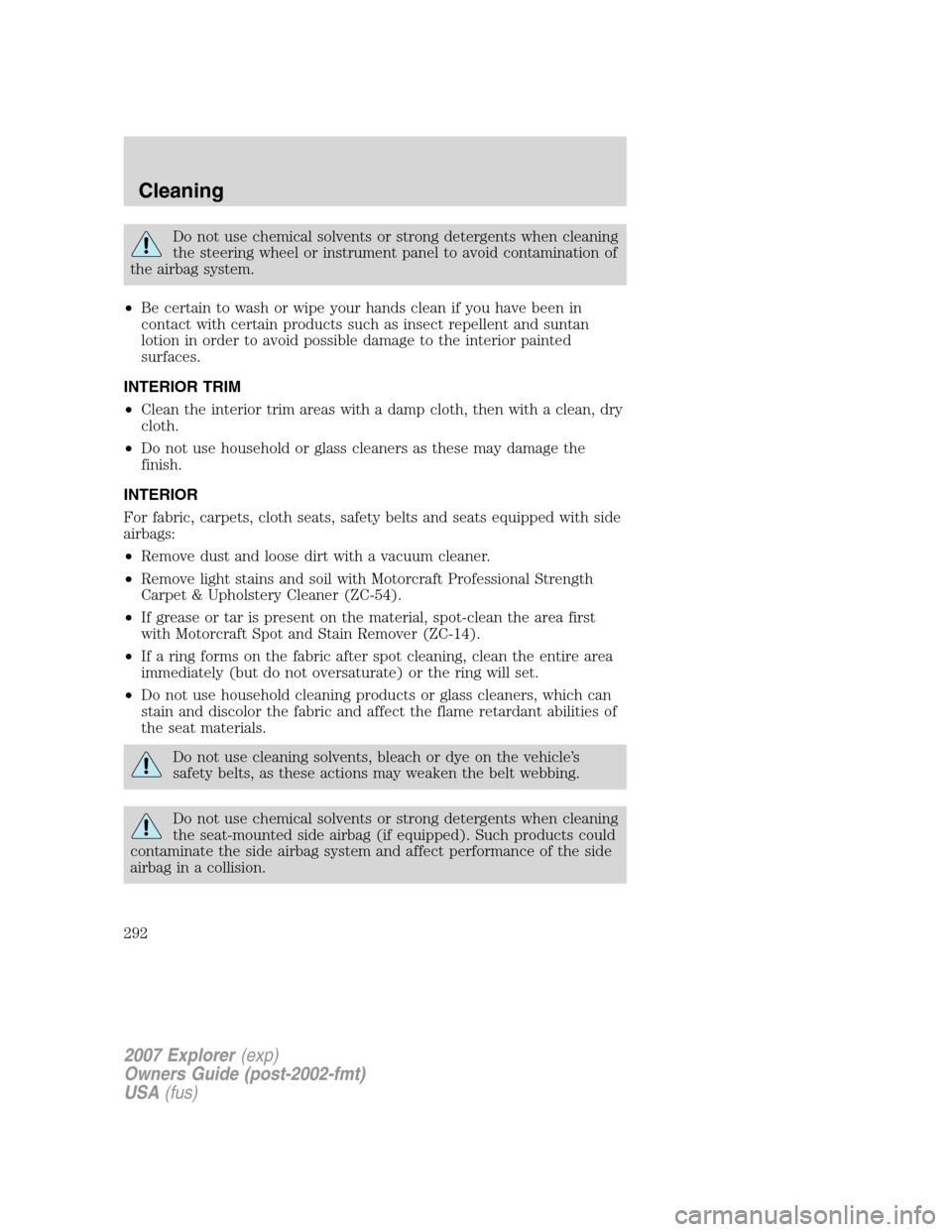
Do not use chemical solvents or strong detergents when cleaning
the steering wheel or instrument panel to avoid contamination of
the airbag system.
•Be certain to wash or wipe your hands clean if you have been in
contact with certain products such as insect repellent and suntan
lotion in order to avoid possible damage to the interior painted
surfaces.
INTERIOR TRIM
•Clean the interior trim areas with a damp cloth, then with a clean, dry
cloth.
•Do not use household or glass cleaners as these may damage the
finish.
INTERIOR
For fabric, carpets, cloth seats, safety belts and seats equipped with side
airbags:
•Remove dust and loose dirt with a vacuum cleaner.
•Remove light stains and soil with Motorcraft Professional Strength
Carpet & Upholstery Cleaner (ZC-54).
•If grease or tar is present on the material, spot-clean the area first
with Motorcraft Spot and Stain Remover (ZC-14).
•If a ring forms on the fabric after spot cleaning, clean the entire area
immediately (but do not oversaturate) or the ring will set.
•Do not use household cleaning products or glass cleaners, which can
stain and discolor the fabric and affect the flame retardant abilities of
the seat materials.
Do not use cleaning solvents, bleach or dye on the vehicle’s
safety belts, as these actions may weaken the belt webbing.
Do not use chemical solvents or strong detergents when cleaning
the seat-mounted side airbag (if equipped). Such products could
contaminate the side airbag system and affect performance of the side
airbag in a collision.
2007 Explorer(exp)
Owners Guide (post-2002-fmt)
USA(fus)
Cleaning
292
Page 325 of 344
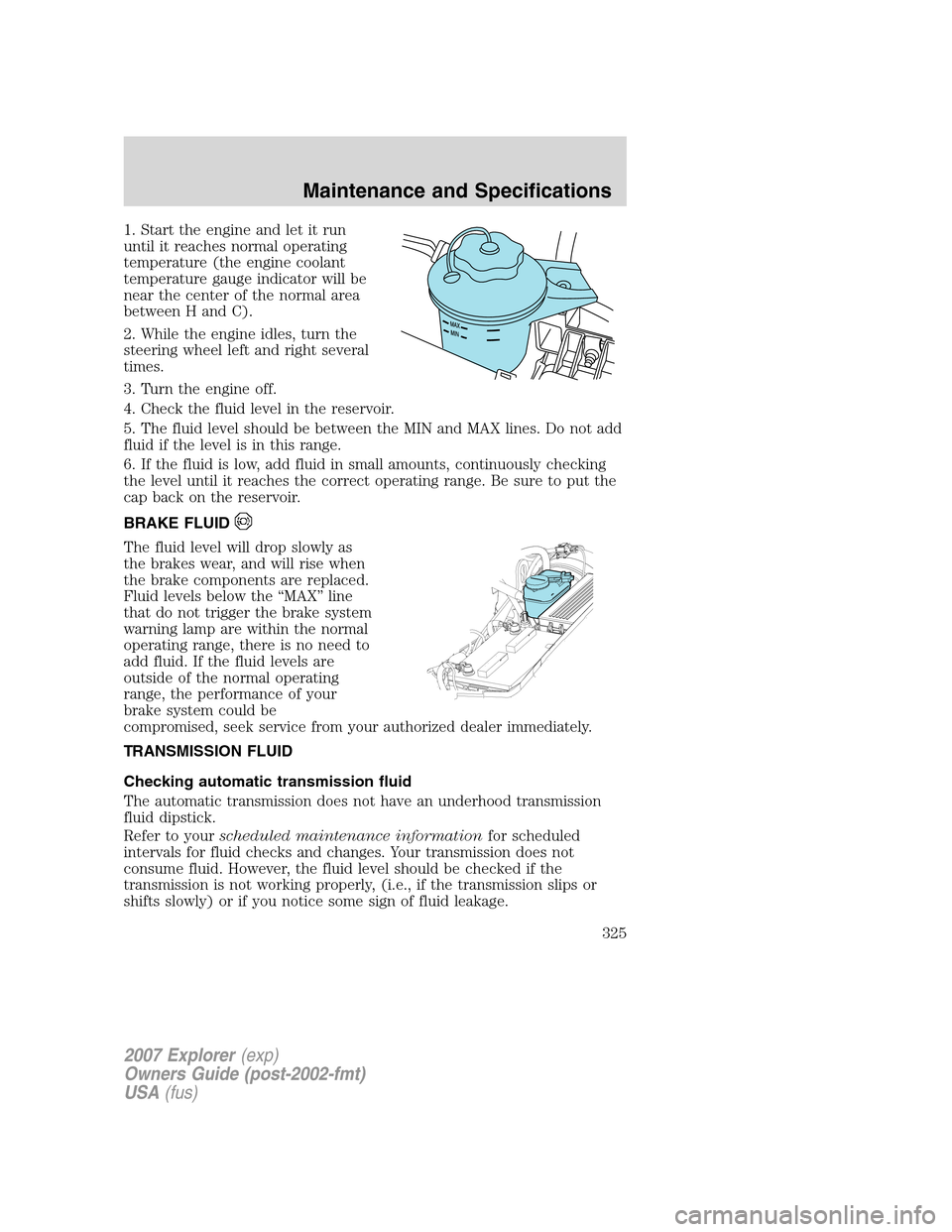
1. Start the engine and let it run
until it reaches normal operating
temperature (the engine coolant
temperature gauge indicator will be
near the center of the normal area
between H and C).
2. While the engine idles, turn the
steering wheel left and right several
times.
3. Turn the engine off.
4. Check the fluid level in the reservoir.
5. The fluid level should be between the MIN and MAX lines. Do not add
fluid if the level is in this range.
6. If the fluid is low, add fluid in small amounts, continuously checking
the level until it reaches the correct operating range. Be sure to put the
cap back on the reservoir.
BRAKE FLUID
The fluid level will drop slowly as
the brakes wear, and will rise when
the brake components are replaced.
Fluid levels below the “MAX” line
that do not trigger the brake system
warning lamp are within the normal
operating range, there is no need to
add fluid. If the fluid levels are
outside of the normal operating
range, the performance of your
brake system could be
compromised, seek service from your authorized dealer immediately.
TRANSMISSION FLUID
Checking automatic transmission fluid
The automatic transmission does not have an underhood transmission
fluid dipstick.
Refer to yourscheduled maintenance informationfor scheduled
intervals for fluid checks and changes. Your transmission does not
consume fluid. However, the fluid level should be checked if the
transmission is not working properly, (i.e., if the transmission slips or
shifts slowly) or if you notice some sign of fluid leakage.
2007 Explorer(exp)
Owners Guide (post-2002-fmt)
USA(fus)
Maintenance and Specifications
325
Page 339 of 344

washing ....................................287
waxing .....................................288
wheels ......................................288
wiper blades ............................291
Climate control (see Air
conditioning or Heating) ............47
Clock adjust
6-CD in dash .............................32
AM/FM/CD .................................26
Compass, electronic ....................87
calibration .................................88
set zone adjustment .........87, 101
Console ..................................66–67
overhead ....................................65
rear ............................................67
Controls
power seat ...............................129
steering column ........................74
Coolant
checking and adding ..............307
refill capacities ................311, 329
specifications ..........................329
Cruise control
(see Speed control) ....................71
Customer Assistance ................250
Ford Extended Service
Plan ..........................................283
Getting assistance outside
the U.S. and Canada ..............284
Getting roadside
assistance ................................250
Getting the service you
need .........................................279
Ordering additional
owner’s literature ...................285
Utilizing the Mediation/
Arbitration Program ...............283D
Daytime running lamps
(see Lamps) ................................54
Defrost
rear window ..............................51
Dipstick
automatic transmission
fluid ..........................................325
engine oil .................................300
Driveline universal joint
and slip yoke .............................326
Driving under special
conditions ..................238, 243, 246
sand .........................................245
snow and ice ...........................247
through water .................245, 249
Dual automatic temperature
control (DATC) ...........................47
DVD system .................................44
E
Electronic message
center .....................................81, 92
Emergencies, roadside
jump-starting ..........................272
Emergency Flashers .................252
Emission control system ..........322
Engine ........................................333
cleaning ...................................289
coolant .....................................307
fail-safe cooling .......................312
idle speed control ...................305
lubrication specifications .......329
refill capacities ........................329
service points ..................297–298
starting after a collision .........252
Engine block heater .................222
2007 Explorer(exp)
Owners Guide (post-2002-fmt)
USA(fus)
Index
339
Page 343 of 344
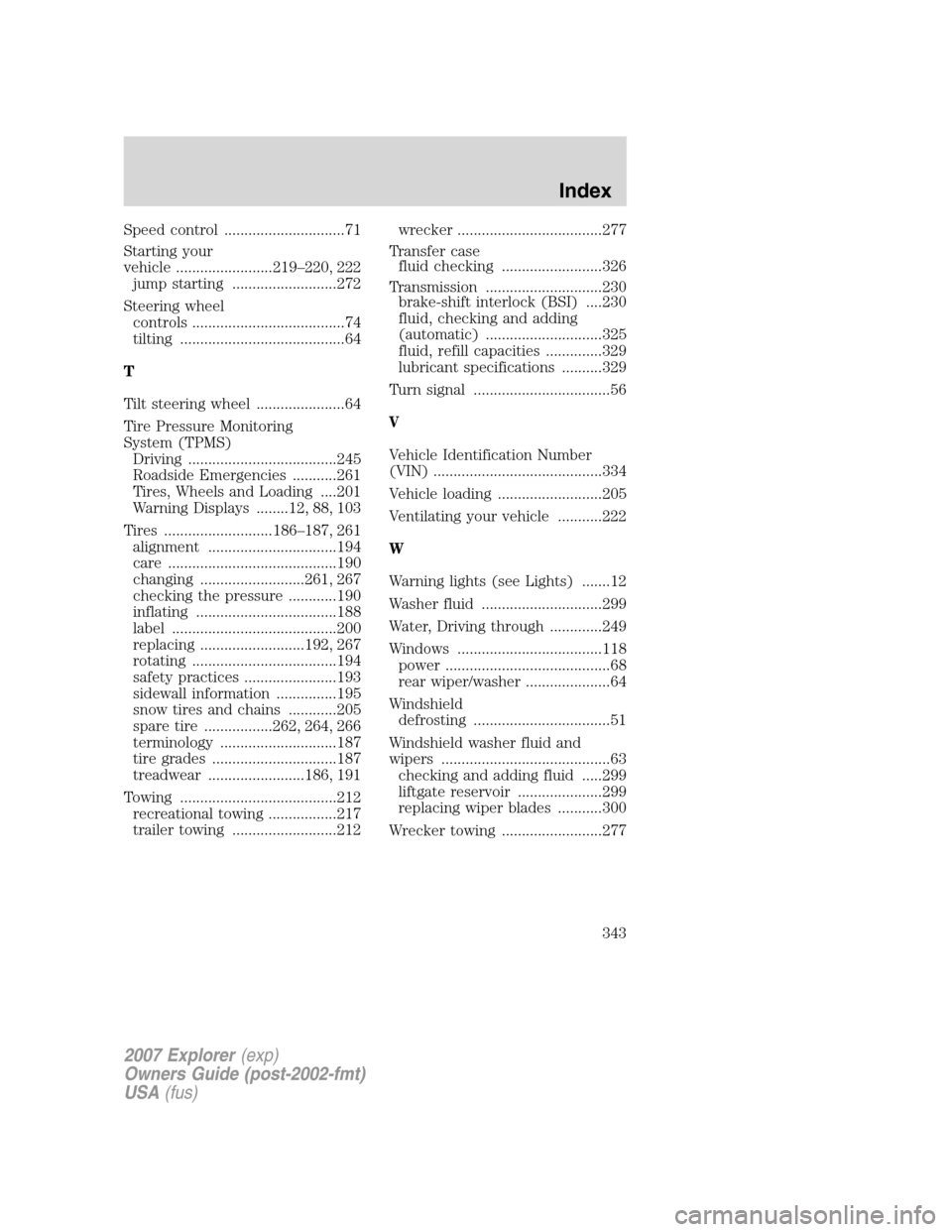
Speed control ..............................71
Starting your
vehicle ........................219–220, 222
jump starting ..........................272
Steering wheel
controls ......................................74
tilting .........................................64
T
Tilt steering wheel ......................64
Tire Pressure Monitoring
System (TPMS)
Driving .....................................245
Roadside Emergencies ...........261
Tires, Wheels and Loading ....201
Warning Displays ........12, 88, 103
Tires ...........................186–187, 261
alignment ................................194
care ..........................................190
changing ..........................261, 267
checking the pressure ............190
inflating ...................................188
label .........................................200
replacing ..........................192, 267
rotating ....................................194
safety practices .......................193
sidewall information ...............195
snow tires and chains ............205
spare tire .................262, 264, 266
terminology .............................187
tire grades ...............................187
treadwear ........................186, 191
Towing .......................................212
recreational towing .................217
trailer towing ..........................212wrecker ....................................277
Transfer case
fluid checking .........................326
Transmission .............................230
brake-shift interlock (BSI) ....230
fluid, checking and adding
(automatic) .............................325
fluid, refill capacities ..............329
lubricant specifications ..........329
Turn signal ..................................56
V
Vehicle Identification Number
(VIN) ..........................................334
Vehicle loading ..........................205
Ventilating your vehicle ...........222
W
Warning lights (see Lights) .......12
Washer fluid ..............................299
Water, Driving through .............249
Windows ....................................118
power .........................................68
rear wiper/washer .....................64
Windshield
defrosting ..................................51
Windshield washer fluid and
wipers ..........................................63
checking and adding fluid .....299
liftgate reservoir .....................299
replacing wiper blades ...........300
Wrecker towing .........................277
2007 Explorer(exp)
Owners Guide (post-2002-fmt)
USA(fus)
Index
343